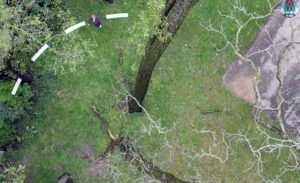By Art Kabelowsky, DNR Forest Health Outreach and Communications, Fitchburg
Arthur.Kabelowsky@wisconsin.gov or 608-335-0167
The Wisconsin Department of Natural Resources (DNR) Forest Health team joined with the DNR Office of Communications to produce an instructional video aimed at helping large landowners and land managers in the fight against spongy moth.
The video, less than 2 minutes in length, shows how to conduct a survey of spongy moth egg masses in the fall. With that information, people can predict how much damage to expect from the caterpillars in the spring, giving them time to make advance plans for the most effective control options.

A drone photo showing recently retired DNR invasive forest insects program coordinator Andrea Diss-Torrance creating a circle to conduct a spongy moth egg mass survey. This picture is part of a new DNR video instructing the public in how to conduct a survey. / Photo Credit: Daniel Robinson, Wisconsin DNR
The video was posted in response to multiple calls to the state spongy moth hotline. Many callers were landowners with woodlots of 10 or more acres interested in getting ahead of potential spongy moth problems. By taking time in the fall to predict the following year’s caterpillar damage, landowners can make advance plans to book an aerial spray (or set up other appropriate control options) for the spring.
Links to the video are also available on the Wisconsin Spongy Moth Resource Center and the DNR’s landing page for spongy moth.
Recently retired DNR invasive forest insects program coordinator Andrea Diss-Torrance appears in the video and provides the narration. The video demonstrates creating a 37-foot circle (1/40th of an acre) around a potentially infested area, carefully counting egg masses inside that circle and then applying mathematics to predict the following spring’s defoliation.
For those who might prefer reading the information over watching it, the University of Wisconsin-Madison put together a webpage on predicting next year’s spongy moth damage. Links to that page also can be found on the Wisconsin Spongy Moth Resource Center and the DNR’s landing page for spongy moth.
